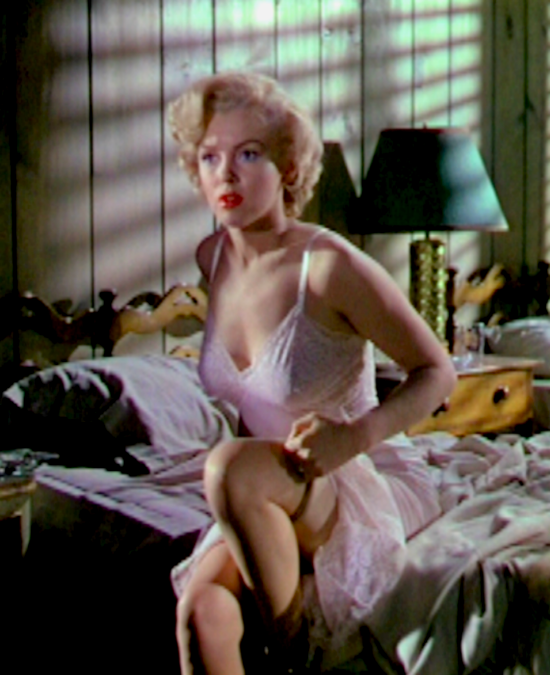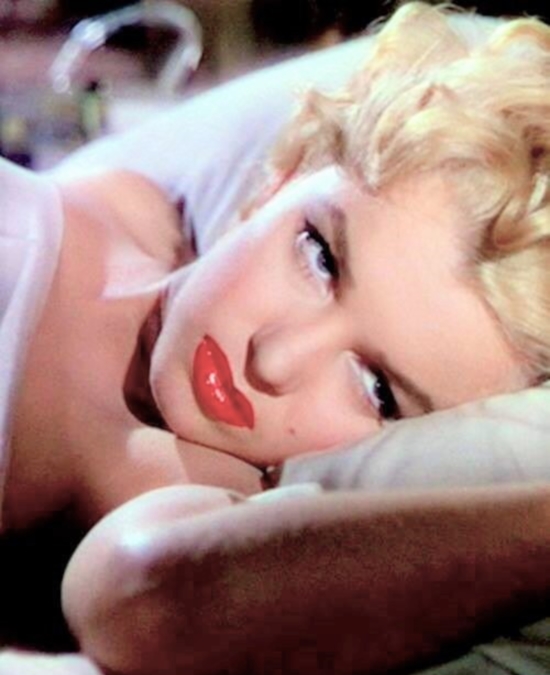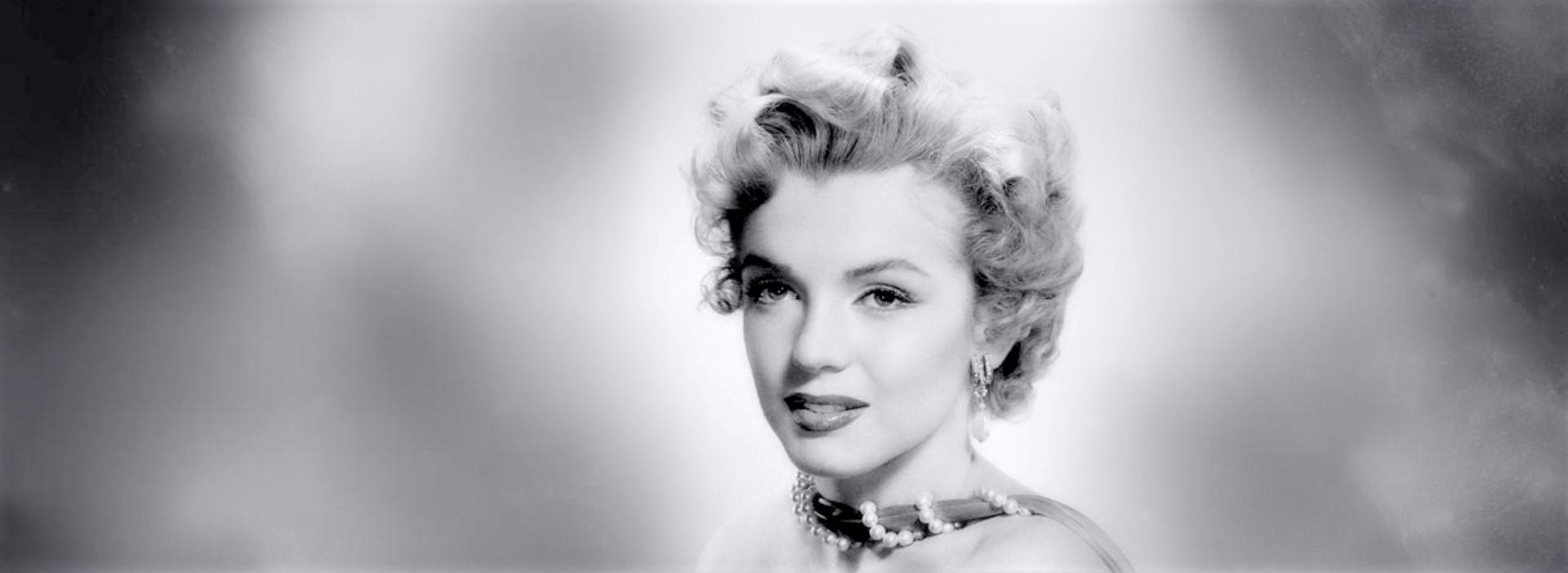Niagara
21 January 1953
Marilyn Becomes A Femme Fatale
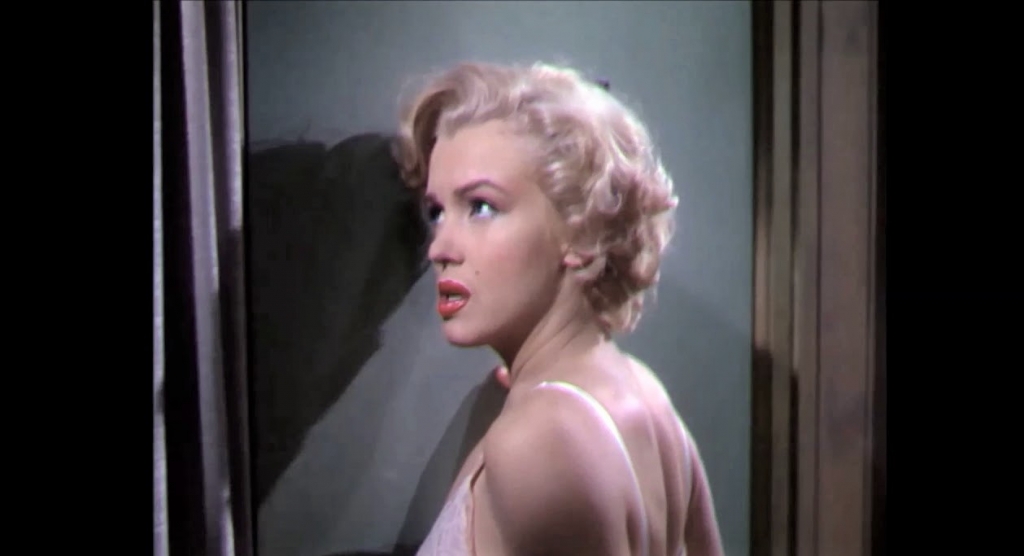
The Marilyn Factor
Marilyn’s appearance in Niagara marks the beginning of her incredible rise to stardom and international fame. Released in January of 1953, Niagara is the first movie in which she receives what amounts to top billing even though her name shares the “starring screen” with Joseph Cotten, who plays George Loomis, and Jean Peters, who plays Polly Cutler.
The part of Polly Cutler was originally offered to and accepted by Anne Baxter; but as originally written, the screenplay focused more on the character of Polly. When Zanuck cast Marilyn as the adulterous Rose Loomis, the studio head directed Charles Brackett, who was writing the screenplay along with Walter Reisch and Richard Breen, to increase Rose’s part while diminishing Polly’s. As a result of Polly’s diminished role, Anne Baxter withdrew. In All About Eve, Anne experienced the negative results of competing with that blonde creature on screen, something she swore she would never again attempt. Jean Peters accepted the role with a promise that she would receive top billing. Apparently, the producers and Fox did not remember their promise.
Marilyn apparently enjoyed a relatively friendly working relationship with her director, Henry Hathaway, and her costars, not a common occurrence due to her insecurities and her fear-generated propensity for tardiness. Known as a tyrannical director, frequently cruel to cast and crew, Hathaway had a tough time negotiating with his often idiosyncratic star. According to Max Showalter, Hathaway sometimes called Marilyn “clabber head” and according to her costar Jean Peters, Marilyn eventually just wore him down. He finally realized that his star was going to play the character her way, regardless of what he wanted or said; so for all intents and purposes, he got out of her way. He advised the other actors to do likewise. Later in his life, Hathaway offered the following observation about Marilyn: I did Niagara with her. I found her marvelous to work with and terrifically ambitious to do better. And bright. She may not have had an education, but she was just naturally bright. He also commented that Marilyn was the best natural actress with whom he had ever worked. Apparently, his one direction for her was to exaggerate everything and she obviously complied; but in the end, he became yet another adoring director who realized that Marilyn was worth the trouble. He also became an ally in her later battles with Darryl Zanuck and her campaign to play Grushenka, a campaign she lost. Henry Hathaway’s legacy is founded on some great movies that he left behind: The Lives of a Bengal Lancer and Airport, noir films 13 Rue Madeleine, Kiss of Death and Call Northside 777, westerns Nevada Smith and How the West Was Won along with four of John Wayne’s movies, including True Grit.
Technicolor Film Noir
I’m not a film noir expert. Even so, since those French words translated into English render “black film”, meaning a movie shot with black and white film, I’m not precisely sure how a Technicolor movie can actually be film noir. Yet many of the expert reviews and commentaries that I’ve read about Niagara classify it as color film noir. Sounds like an oxymoron to me. Besides, the landscapes of film noir are usually crumbling cities with filthy streets inhabited by criminals, cynics and other assorted miscreants, like those featured in The Asphalt Jungle, not Niagara Falls. But, I’m not going to quibble. If the experts want Niagara to be film noir then film noir it is. Like I said: I’m not a film noir expert.
Introductions
Normally, a movie has one major opening scene devoted to introducing characters, perhaps themes, metaphor and motif; but Henry Hathaway’s Niagara is unusual because it has three such scenes. The initial introductory scene at the waterfalls introduces George Loomis and leads to the interior scene with his wife, Rose. The second introductory scene at the border introduces Ray and Polly Cutler, a young American couple from Toledo, Ohio, visiting Niagara for a delayed honeymoon. And then a third scene at the Rainbow Cabins where the Cutlers meet Rose, which starts the story and leads to their deadly entanglement in a melodrama of deceit, adultery, murder and revenge.
Each person, each couple and their relationships have a symbolic significance within the story’s framework. The landscape of Niagara is contrapuntal as are the individual relationships, the deportment of each couple and the deportment of the main characters.
Hathaway introduces three metaphors during the opening scene: the ubiquitous waterfalls, rainbows, which appear and disappear throughout the movie, and the most powerful, evocative metaphor, Rose Loomis, the femme fatale, the siren Lorelei, a powerful force equated with the unstoppable falls.
Contrapuntal Landscape
The city of Niagara presents an almost serene landscape against which deceit and adultery, the murder of Patrick and Rose, and the death of George occur. The locale introduces a point counterpoint motif. Even though Niagara Falls is high on the list of favorite suicide sites in North America, as a destination for newlyweds and vacationing tourists, Niagara is normally associated with family and happiness, love and beginnings, not jealousy, anguish, divorce and death. On the average, twenty-five persons per year kill themselves by going over the falls and authorities claim the exact number of suicides per year may be even higher. The city’s idyllic appearance adds to the disturbing nature of that suicide statistic, the movie’s dark violence and speaks to the idiom that one never knows what evil or desperation lurks behind closed doors or in the minds of men and women.
Polly Cutler
The point counterpoint motif is reinforced and amplified by juxtaposing Polly with Rose, both attractive but disparate young women, Polly the normal one, Rose the abnormal one. During George’s rant about Rose’s lurid attire, he asks Polly if she would wear a cut-to-the-knee-caps dress. Polly differentiates herself from Rose when she confesses: I’m not the knee cap type.
Polly certainly is not the type of woman who flaunts herself but neither is she a prude. At the US and Canada border, the guard asks Ray if a box in the car’s back seat contains liquor. Ray tells the guard the box contains books: he intends to catch up on his reading. As they depart the check point, here’s the dialogue:
Polly: Fine thing. I tell him we’re on our honeymoon and you drag out a copy of Winston Churchill. He must think I’m a pretty hard article.
Ray: You shoulda told him we’re on a delayed honeymoon.
Polly: Delayed or not, we agreed to treat it like a regular one, didn’t we.
Ray: I’m game. It’ll be just as good as a regular honeymoon.
Polly: Well, it should be better: got my union card now.
For months, Polly’s reference to her union card mystified and stumped me. What did union membership have to do with her honeymoon? My daughter-in-law, Nancy, suggested that Polly was referring to her membership in the I-know-what-sex-is-all-about union of women. She is also telling Ray that she intends to show him a good time and that the quality of her sexual performances will exceed those of her wedding day because she is now a non-virgin and appropriately experienced, has earned her union card. In the fifties, a frank exchange, even between husband and wife, regarding their sex lives was not allowed and the word virgin could not be spoken. Additionally, the reference to a union card also implies that her roles as wife and lover are basically her job.
Still, Polly represents the ideal wife, one who does not flaunt her considerable sexuality and beauty. She is loyal, committed and compliant, the wife-mother, directed by the norms of society but also her humanity. After George injures his hand in a fit of rage, it’s no surprise that Polly volunteers to mother him; and in spite of his behavior, Polly sympathizes with George. She knows what Rose is; but because of her sympathetic nature, Polly attempts to dismiss Rose’s slutty demeanor, even after seeing her with Patrick, an event she never reveals to anyone except Ray.
During their encounter at the Cave of the Winds after Patrick’s murder, Polly appears conflicted about George’s request for her help. Later, during her conversation with the detective, she only reveals that George is alive after she learns Rose has exposed herself to him, and possibly to murder, by leaving the hospital. Apparently, Polly had decided to help George escape. This deviation from the societal norm, reporting murder and murderers, makes Polly an accessory after the fact in Patrick’s murder and slightly complicit in Rose’s murder. Her silence and her complicity nearly cause her death.
George Loomis
The initial scene features the raging waterfall, a rainbow and George. The camera angle emphasizes the size and power of the falls and the smallness of George. He comments on his small size and irrelevance to the falls and nature: he is not necessary to them. Since the waterfall is also a metaphor for Rose, George is also small and irrelevant to her.
He appears to be walking toward the end of the rainbow where that mythical pot of gold awaits. In Celtic mythology, the pot is a female symbol from which springs the gold of new life, a man’s progeny, his only real chance at immortality: the rainbow’s arc reflects the arc of a pregnant female’s protuberant belly.
After his monologue, George returns to the appropriately named Rainbow Cabins, where Rose awaits. He does not find a pot of gold or a pregnant female; but if Rose was pregnant, could George be certain of his paternity? He calls to Rose plaintively, with a trace of supplication in his voice; and his facial expression suggests his love, his longing for her is tainted by doubt and distrust.
George’s distrust has become an obsession fueled by jealousy. He’s lost control of his feelings, lost the ability to control his rage. He snaps later in the movie, gashes his hand as he breaks the phonograph record, the symbol of Rose’s lover. His angry display both foreshadows and symbolizes Patrick’s murder and how George figuratively and literally bleeds over Rose’s infidelity; and even though she’s a tramp, he’s stuck; he’s trapped.
Aware of his predicament, George warns Polly that love can get out of control; it can be just as destructive and deadly as hate. George equates his situation to the current of the river and the inevitable plunge over the edge, certainly foreshadowing. Angrily, he destroys the model car he’s worked to build, kicks over the nearby table, implying that George will eventually destroy his life. As Polly realizes, George likes to suffer. Like a man with a painful, decaying tooth, he cannot prevent himself from touching it with his tongue.
As a veteran, George represents many WWII soldiers who returned home from combat only to find their wives involved in adulterous relationships, aggravating the trauma of war. He also represents male anxieties and fears that appeared during the decade of the fifties, anxiety over the nascent sexual freedom of women, anxiety over their loss of control and fear of emasculation at the hands of Rosie the Riveter. Rosie, who represented the changing roles and attitudes of women about their place in American Society, was associated with two real women, Rosalind Walter, who inspired the song, “Rosie the Riveter”, and Rose Will Monroe, who was born in Pulaski County, Kentucky. Marilyn had ancestral ties to Kentucky through her grandmother, Della Mae Hogan, whose family immigrated to the Blue Grass State from Tipperary, Ireland. Gladys, Marilyn’s mother, was married to Kermit Baker, a native of Kentucky and Marilyn, then Norma Jeane Dougherty, was a factory worker at Radioplane Munitions during the final stages of WWII. The obvious connection of the names Rose and Monroe is oddly chilling. At times, synchronicity is eerie.
Ray Cutler
Similar to Polly and Rose, contrasts are drawn between George and Ray. While George is insanely jealous of Rose’s sexuality; Ray encourages Polly to reveal hers. When Rose appears in her revealing, hot pink dress, Ray suggests that Polly should get a similar one but she dismisses the idea. Ray wants her to intentionally accentuate her body, to inhale and expand her breasts; but Polly is not that kind of woman, so his requests make him appear silly and comic.
After Polly encounters the not-dead-George in their cabin, Ray treats her disrespectfully, like she’s a child suffering from dream-induced hysteria and simply needs the calming effects delivered by a glass of water. In the presence of the police detective, Ray contradicts her, dismisses her, says she needs her head examined.
Viewed across the sixty-seven years since Niagara’s release, Ray’s treatment of his wife seems more than sexist. But dread and doom loom over Niagara like a shroud, so much so that Ray is comic relief. A caricature of the often parodied stereotypical company man, Ray is much too excited by the shredded wheat plant across the river; and most of the time, he’s lost in a myopic fog caused by his inability to see much beyond his career aspirations. Ray is a younger version of Mr. Kettering, the man Ray will become. In contemporary parlance, Ray is a nerd, a dweeb; but he delivers two of the movie’s few humorous lines. After George smashes the phonograph record, Ray says: It looks like your husband doesn’t like music, Mrs. Loomis and then he comments that he and Polly didn’t need new clothes for their belated honeymoon, all they needed were a couple of shrouds.
Rose Loomis
As her name suggests, Rose is a beautiful flower, one with deadly poisonous thorns, but nonetheless a creation of nature, a powerful force as well, like Niagara Falls. In Fox’s advertising campaign, Rose and Marilyn are directly equated with the raging falls; and on the cinema lobby posters, she is pictured in a siren’s pose, lying on her side atop the horseshoe shaped falls with water flowing over her sumptuous curves: Marilyn Monroe and Niagara, a raging torrent of emotion that even nature can’t control.
Her first scene in the movie is an unforgettable one. In bed, obviously naked under a single sheet that barely covers her breasts, her knees are splayed apart in an inviting, sexual manner. She sensually rocks them back and forth as she idly smokes her cigarette. Rose appears to be a woman who has just finished copulating and is now relaxing, enjoying the sensations, or a woman who is daydreaming about a previous sexual encounter. Her disregard for George, once he enters the bungalow, the look of disgust on her face and in her eyes, suggests her daydream did not include him. She turns her back to him, her harsh statement of repudiation and disrespect.
In her next scene, seated on her bedside pulling on her stockings, when the resort manager knocks, she leans forward out of the shadows. Her crimson lips, her beauty and her effulgence are powerful. Just before she steps outside for her initial encounter with Polly and the resort manager, she pauses briefly like an actress taking a few seconds to relax before an important scene. A consummate actress, she is also an intelligent master manipulator; and once outside, she is the very embodiment of sweetness and concern. Later, she belies this presentation when she refuses to attend George’s cut hand. Considering how he behaves, we understand why Rose chose to avoid him; but the violent record breaking episode was caused by Rose. She goaded him into his insanely angry and public outburst; and she has, George correctly predicts, a reason.
During her telephone conversation with Patrick after George’s angry and violent outburst, she reveals her reason. By telling Polly that her husband, a veteran, had been treated in a psychiatric hospital, Rose prepared everyone for George’s insane antics. A conniving, duplicitous woman, considering the way she smirks at the telephone after her chat with Patrick, I found myself wondering what plans she possibly had for him after George’s murder; and while her manipulation of Polly and Patrick is expert, Rose’s manipulation of her husband rises to the level of art with its effective cruelty.
After his violent display, she plies him with sex the following morning, briefly making George calm and happy; but then Rose begins to dress. She is going to leave, which incites the angry George, the desperate George. He can read the signs, feel and smell the presence of another man in Rose’s life. Rose heartlessly ridicules her husband. He’s an insane, paranoid simpleton; and just before she leaves the bungalow, she chides him.
Rose is aware that George is insanely jealous and obsessed with her. She knows he cannot stop himself from following her, first to the bus station and then to the tunnels where Patrick awaits. When George buys a ticket to the tunnels, Patrick follows him into the elevator, going down.
Rose is an evil woman but she is not completely lacking a conscience. Briefly, back in the bungalow, after springing her murderous trap, she stands before the window overlooking the falls, probably thinking about what’s going to happen to George. She snaps the horizontal blinds closed and hangs her head, now in black silhouette, shamefully; but it’s too little and too late. She and Patrick and George, and to a certain degree Polly Cutler as well, are all like the logs George described for Polly, caught in the lower rapids, flowing inexorably toward the edge.
Murder and Punishment
We are not allowed to witness the violence associated with Patrick’s murder; but we get an intimate view of Rose’s; and we are virtually included in what God’s retribution visits upon George. The wages of sin, after all, is death.
George’s pursuit of Rose is filled with foreboding and tension. We definitely sense her fear, her desperation and her panic. When she makes it to the seventh level of the bell tower, she has not reached Heaven. As she struggles to stop George’s advance, she becomes a sympathetic character: maybe killing George was the only way she could ever be free of his insane jealousy and obsessive love. Too bad they can’t play it for you now, George chides Rose as he slowly approaches her, referring to the song she shared with Patrick. She plaintively, almost inaudibly, speaks his name. Once George grabs her throat, Rose doesn’t struggle at all and she doesn’t scream. In the silence, George kills her easily, ripping the white scarf from her throat as she falls.
Afterwards, he flees the scene but he tower doors are locked; so he heads back up the stairs where he encounters the contents of Rose’s purse, spilled on the floor during her attempt to escape. He kneels and picks up her lipstick, its case encrusted with fake emeralds, rubies and diamonds, the symbols of Rose’s false allure. The glittering, multicolored symbol of his wife is also one final allusion to the rainbow motif, albeit a false one. He opens it, twirls it to reveal the blood red lipstick, the symbol of her lust and her carnality.
Continuing up the stairs, he reaches her lifeless body. While holding her lipstick and her white scarf, two images of Rose, one living, one dead, that he’ll carry with him when he attempts to escape, he speaks to her softly, piteously. Almost a supplication for forgiveness, he says: You know I loved you, Rose. Punishment is all that awaits George.
Sub Textural Images
Complex and intriguing sub textural images abound in Niagara. In an early scene, we view Niagara Falls through a tangle of wires. Should we interpret that image as the tangled lives and emotions of Rose and George, the tangled lives of the Loomises and the Cutlers or the oddly tangled nature of life in general.
After Polly complies with Ray’s request to accentuate her body for a photograph, Rose arrives to cast her shadow across the scene, suggesting what exactly―that in Ray’s eyes, Rose overshadows his wife or that the very presence of Rose has an overshadowing effect on all women, or that Rose is simply a darkness?
Although I hesitate to label the centrally located bell tower a phallic symbol, primarily due to its non tubular shape, I concede that it suggests an erection; and locating Rose’s murder inside the tower creates an evocative but grotesque image. Similarly, I hesitate to call the tunnels and caves vaginal symbols, but damp, dark recesses are usually viewed as such. Locating Patrick’s murder inside a tunnel creates another evocative image.
And finally, to close the loop on the rainbow motif, in Christian symbology, the rainbow represents God’s promise that He will never again destroy all life on Earth with water. By extension, rainbows represent the promise of redemption and forgiveness. The final rainbows appear when George confronts Polly at the Cave of the Winds. At that point, there was still hope for him, assuming he killed Patrick in self-defense; but after he kills Rose, his chance for redemption dies with her. Fittingly perhaps, the device of God’s retribution for George is the water of Niagara Falls.
Cinematography
A bright, beautiful landscape, sumptuously filmed in Technicolor is not what one expects to see in a film noir. Joe MacDonald was Henry Hathaway’s Call Northside 777 cinematographer in 1948 and he would later team with Jean Negulesco and film How to Marry a Millionaire.
Both Henry and Joe understood the common elements of film noir and how to utilize the techniques effectively. George’s face, for instance, is usually framed and lit to reveal and project his menacing character while Rose, Polly and Ray are lit and photographed in a more conventional, contrasting manner. An exception is the scene during which Rose becomes a black silhouette after she springs her murder trap and then during her pursuit and murder scene.
The bell tower photography employs partially lit faces and shots that are mostly fields of black pierced by narrow shreds of light. As George approaches Rose we only she her shadow; and the shot of Rose, just before her murder, is particularly sensational. One side of her face is brightly lit by sunlight streaming through an open louver, the other side darkened by shadow, the white scarf around her neck highlighted by her dark outfit and surrounding black field. Behind her is a lurid section of blood red wall. A red light just above her head imparts a red glow to her blonde hair. She is the ultimate red woman.
After her strangulation, she crumples to the floor. Her motionless body is framed by an oddly shaped patch of light crossed by bars of shadows while she still clutches her green silk scarf.
Score
Some reviewers criticize Sol Kaplan’s Niagara score as being overly melodramatic; but then melodrama abounds in Niagara so I fail to see the problem with a melodramatic score. When required, the score appropriately reflects and amplifies the few funny moments in the movie, few though they are. Moreover, the use of music as a tonal device within the movie is sparse: it is mostly used as an accentuating device. It dominates the pursuit scene but then completely disappears during the actual murder of Rose. The horror of her strangulation, although it mostly occurs off camera, is heightened by the absence of music, the eerie silence.
“Kiss” was written specifically for Niagara by Lionel Newman and Haven Gillespie and Kaplan totally integrated the song into the score. Its melody and variations thereof permeate the music. The scene during which Polly sees Rose and Patrick osculating features a brief piece of foreboding music that is a variation of the “Kiss” melody as is the music during Rose’s pursuit.
Marilyn recorded both “Kiss” and “Do It Again” for MGM Records but neither were released at that time because of the controversy generated by the movie. During her performances for the troops in Korea in early 1954, she performed “Do It Again” during her first show and nearly caused a riot. In subsequent appearances, she changed the lyrics at the Army’s request and lowered the heat of her delivery.
Screenplay
Crisis and moral dilemma are essential to a dramatic story. While the crisis and moral dilemma faced by each character in Niagara creates a certain amount of tension and suspense, the fundamental plot is slightly hackneyed; and even though Niagara is an above average version of the adulterous wife schemes to murder husband scenario, elevated by taut, realistic dialogue, the screenplay is perforated by a few plot holes. Where does George murder his rival, for instance? If during the tunnel tour, wouldn’t other tourists be present? How does George manage to get Patrick’s body out of the tunnel and to the river unseen? Wouldn’t the authorities have finger-printed the corpse to ensure it was George Loomis since Rose never actually identified it? After all, George was a veteran who had once been in a psychiatric hospital for veterans.
These holes, and others, don’t diminish the movie’s overall effect and quality. Darryl Zanuck’s slice and dice method of shortening movies, with little or no regard for impact, probably created most if not all of the plot holes I mention. However, the absence of any real back story is particularly bothersome.
The scene with George and Polly, after George gashes his hand, is a prime example of using dialogue to provide back story; and while somewhat effective, an additional amount of background information would have given the characters more depth and generated more pathos for the ones who die, especially Patrick. I concede that characters like Rose need a certain mystery to render their coldblooded natures not necessarily believable but acceptable; however, not knowing how Rose, George and Patrick became a dangerous triangle creates an emptiness.
But the screenplay’s one real weakness is the unsatisfying ending. With Rose’s death nearly thirty minutes before the movie ends, all that’s left is administering George’s punishment. Even though Polly is placed in a dangerous situation with George, a man attempting to escape his punishment, I never thought for one minute that he was going to harm her or that she was going to share his inevitable fate. I say inevitable because the fifties Production Code required the punishment of crimes like murder, either at the hands of authorities or at the Hand of God.
And finally, for the Niagara police detective to ask Polly to forgive Niagara Falls for her harrowing, near death experience and return for a visit in the future is, at best, a wonderful example of anticlimax.
Performance
A movie can have a good, even a great story, a great musical score, great cinematography and dialogue; but if the actors do not perform the scenes and deliver the dialogue in a natural and believable manner, all that is great will be ruined. In Niagara, the actors deliver more than credible performances. Even Max Showalter, described by critics as an actor who did not keep Marlon Brando awake at night, portrays Ray Cutler convincingly. Ray is just a dweeb and Polly is certainly his more than better half. With her olive complexion and her all-American-girl-next-door-looks, Jean Peters inhabits Polly Cutler’s skin rather comfortably. Why she finds Ray attractive may be a mystery; but due to the humanity that Jean transmits though Polly and her often self-effacing comments, I accept that she could and would marry a dweeb. Also, Jean clearly conveys through her eyes and facial expressions, the anguish caused by Polly’s moral dilemma; but because of her sympathetic nature, I believe she would have remained silent, allowing George to escape.
George is a complex character and Joseph Cotten invests him with equal parts self-pity, menace, anger and obsessive vengefulness. Joseph’s performance is skillful and intensely dark. I believe that his obsessive love for Rose is so intensely warped that he could, in fact, kill her with his bare hands because if he could not possess Rose, then nobody could.
A carnal and wicked woman, Rose is an interesting departure for Marilyn, the only amoral woman she ever portrayed; and Niagara is the only movie in which her character dies. Absent are the innocence and the vulnerability that, during her career, virtually cloaked her. She is overtly sexual in a coldblooded, manipulative manner, so much so that her carnality approaches cruelty. She is so hot that her intense presence somewhat overpowers Marilyn’s performance. Still, she adroitly portrays Rose, creates a believable woman who is somewhat empathetic, in spite of her malevolent, murderous carnality and her mysterious past. Prior to telephoning Patrick to set up their rendezvous and George’s murder, she glances outside to see if anyone is there to overhear her and then, while peering in a mirror, rubs a lipstick smudge from her teeth, a piece of business that gives Rose a definite realism: how many times have I seen women do that very thing.
Marilyn was very adept at transmitting emotions with her eyes and the look she gives Patrick, as he enters the gift shop for his confrontation with George, is about as libidinous as a look can be. There are many other moments in the movie when Rose speaks without speaking, her now famous sexual ambulation notwithstanding.
Contemporaneous Perceptions
Marilyn’s portrayal of Rose Loomis was alternately praised and criticized, as usual. Some called her sluttish and whorish; and sometimes those adjectives were also applied to Rose. According to Bosley Crowther, the Curmudgeon Critic:
Perhaps Miss Monroe is not the perfect actress at this point. But neither the director nor the gentlemen who handled the cameras appeared to be concerned with this. They have caught every possible curve both in the intimacy of the boudoir and in equally revealing tight dresses. And they have illustrated pretty concretely that she can be seductive―even when she walks.
A critic writing for The New Yorker offered this commentary:
Marilyn Monroe, who Hollywood has been ballyhooing as a new-day Lillian Russell, takes a fling at big-league melodrama in Niagara and demonstrates a wide assortment of curves and a tendency to read her lines as if they were written in a tongue she is not entirely familiar with.
O what a meaningless and stupid assessment. For a twenty-first century perspective, Christopher Zabel, writing for DoBlu.com offered the following:
A tense thriller with excellent pacing and characterization, Niagara is one of those timeless movies that would have worked in any era. It is Marilyn Monroe’s radiant star that adds the cherry on top of the cake. If any woman was born for three-strip Technicolor, it was Marilyn with her ruby-red lips and dyed blonde hair in Niagara. Her charisma in the role of Rose adds another dimension to the masterful film. There is more psychological depth to the characters than was usual for the period, as it explicitly deals with George’s mental problems and his motivations in marrying Rose.
Several female groups protested what they called Marilyn’s frank characterization of Rose because she and it were having an undesirable effect on their husbands, sweethearts and children. During her shower scene, Marilyn is most certainly naked. Blindsided and blinded by her frank sexuality, obviously the decade of the fifties was not ready for Marilyn Monroe. The New Yorker certainly wasn’t.
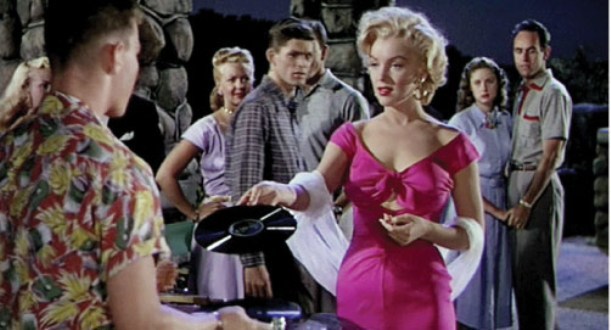
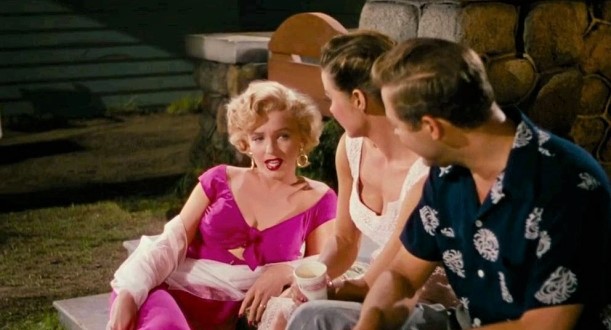
Gentlemen Prefer Blondes
In the advertising campaign for Niagara, Rose was described as a Lorelei, luring men to their destruction. On June the 1st of 1952, Marilyn’s 26th birthday, Darryl Zanuck notified her she was being assigned to play Lorelei Lee in Howard Hawks’ Gentlemen Prefer Blondes.
With the release of Niagara in January of 1953, Gentlemen Prefer Blondes on the 1st of July and How to Marry a Millionaire on the 4th of November, the country and the world became, by the end of 1953, very familiar with Marilyn’s power, appeal and incredible allure. The love-hate relationship began in earnest.
